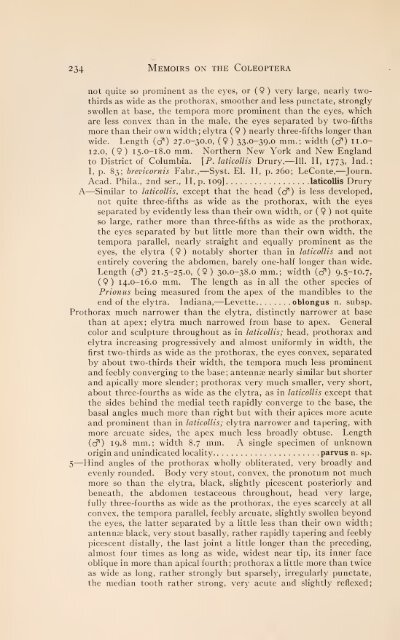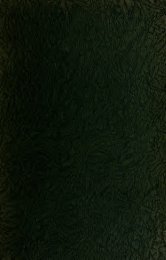Memoirs on the coleoptera
Memoirs on the coleoptera
Memoirs on the coleoptera
Create successful ePaper yourself
Turn your PDF publications into a flip-book with our unique Google optimized e-Paper software.
234<br />
MEMOIRS ON THE COLEOPTERA<br />
not quite so prominent as <strong>the</strong> eyes, or ( 9 ) very large, nearly two-<br />
thirds as wide as <strong>the</strong> prothorax, smoo<strong>the</strong>r and less punctate, str<strong>on</strong>gly<br />
swollen at base, <strong>the</strong> tempora more prominent than <strong>the</strong> eyes, which<br />
are less c<strong>on</strong>vex than in <strong>the</strong> male, <strong>the</strong> eyes separated by two-fifths<br />
more than <strong>the</strong>ir own width; elytra ( 9 ) nearly three-fifths l<strong>on</strong>ger than<br />
wide. Length (cf) 27.0-30.0, (9) 33.0-39.0 mm.; width (cf ) ll.o-<br />
12.0, (9) 15.0-18.0 mm. Nor<strong>the</strong>rn New York and New England<br />
to District of Columbia. [P. laticollis Drury, 111. II, 1773, Ind.;<br />
I, p. 83; brevicornis Fabr., Syst. El. II, p. 260; LeC<strong>on</strong>te, Journ.<br />
Acad. Phila., 2nd ser., II, p. 109] laticollis Drury<br />
A Similar to laticollis, except that <strong>the</strong> head (c?) is less developed,<br />
not quite three-fifths as wide as <strong>the</strong> prothorax, with <strong>the</strong> eyes<br />
separated by evidently less than <strong>the</strong>ir own width, or ( 9 ) not quite<br />
so large, ra<strong>the</strong>r more than three-fifths as wide as <strong>the</strong> prothorax,<br />
<strong>the</strong> eyes separated by but little more than <strong>the</strong>ir own width, <strong>the</strong><br />
tempora parallel, nearly straight and equally prominent<br />
as <strong>the</strong><br />
eyes, <strong>the</strong> elytra ( 9 ) notably shorter than in laticollis and not<br />
entirely covering <strong>the</strong> abdomen, barely <strong>on</strong>e-half l<strong>on</strong>ger than wide.<br />
Length (cf) 21.5-25.0, (9) 30.0-38.0 mm.; width (cT) 9.5-10.7,<br />
(9) 14.0-16.0 mm. The length as in all <strong>the</strong> o<strong>the</strong>r species of<br />
Pri<strong>on</strong>us being measured from <strong>the</strong> apex of <strong>the</strong> mandibles to <strong>the</strong><br />
end of <strong>the</strong> elytra. Indiana, Levette obl<strong>on</strong>gus n. subsp.<br />
Prothorax much narrower than <strong>the</strong> elytra, distinctly narrower at base<br />
than at apex; elytra much narrowed from base to apex. General<br />
color and sculpture throughout as in laticollis; head, prothorax and<br />
elytra increasing progressively and almost uniformly in width, <strong>the</strong><br />
first two-thirds as wide as <strong>the</strong> prothorax, <strong>the</strong> eyes c<strong>on</strong>vex, separated<br />
by about two-thirds <strong>the</strong>ir width, <strong>the</strong> tempora much less prominent<br />
and feebly c<strong>on</strong>verging to <strong>the</strong> base; antennae nearly similar but shorter<br />
and apically more slender; prothorax very much smaller, very short,<br />
about three-fourths as wide as <strong>the</strong> elytra, as in laticollis except that<br />
<strong>the</strong> sides behind <strong>the</strong> medial teeth rapidly c<strong>on</strong>verge to <strong>the</strong> base, <strong>the</strong><br />
basal angles much more than right but with <strong>the</strong>ir apices more acute<br />
and prominent than in laticollis; elytra narrower and tapering, with<br />
more arcuate sides, <strong>the</strong> apex much less broadly obtuse. Length<br />
(cT) 19.8 mm.; width 8.7 mm. A single specimen of unknown<br />
origin and unindicated locality parvus n. sp.<br />
5 Hind angles of <strong>the</strong> prothorax wholly obliterated, very broadly and<br />
evenly rounded. Body very stout, c<strong>on</strong>vex, <strong>the</strong> pr<strong>on</strong>otum not much<br />
more so than <strong>the</strong> elytra, black, slightly picescent posteriorly and<br />
beneath, <strong>the</strong> abdomen testaceous throughout, head very large,<br />
fully three-fourths as wide as <strong>the</strong> prothorax, <strong>the</strong> eyes scarcely at all<br />
c<strong>on</strong>vex, <strong>the</strong> tempora parallel, feebly arcuate, slightly swollen bey<strong>on</strong>d<br />
<strong>the</strong> eyes, <strong>the</strong> latter separated by a little less than <strong>the</strong>ir own width;<br />
antennae black, very stout basally, ra<strong>the</strong>r rapidly tapering and feebly<br />
picescent distally, <strong>the</strong> last joint a little l<strong>on</strong>ger than <strong>the</strong> preceding,<br />
almost four times as l<strong>on</strong>g as wide, widest near tip, its inner face<br />
oblique in more than apical fourth; prothorax a little more than twice<br />
as wide as l<strong>on</strong>g, ra<strong>the</strong>r str<strong>on</strong>gly but sparsely, irregularly punctate,<br />
<strong>the</strong> median tooth ra<strong>the</strong>r str<strong>on</strong>g, very acute and slightly reflexed;



